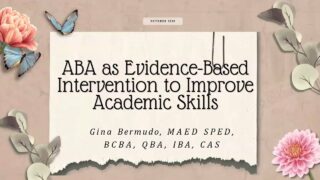The Language of Art | Dr. Roberto Paulino
The Language of Art
Dr. Roberto Paulino
Hello! Welcome to this video on The Language of Art.
Like other fields of study, the arts have their own specialized vocabulary. The artists’ distinctive use of the vocabulary of formal elements, materials and techniques, composition—together with the various contexts of the production of art—contribute to the meaning of the work. Although these aspects are discussed in separate modules in the Arts 1 syllabus to help focus the discussion, in practice they are not isolated but are dynamically interrelated, thereby producing a complex structure. Many general education courses in the arts include the visual arts, such as painting and sculpture as well as music. However, do note that such dynamics among elements, medium, technique and context in the production of meaning also hold true for sculpture, cinema, theatre, dance as well as the traditional arts.
In visual art and architecture, the term form refers to its purely visual components such as line, shape, color, light, texture, and space. These components are known as formal elements. They are like building blocks used to create an artwork. Formal analysis thus, is the visual analysis of artistic form. The emphasis on the formal elements rather than the subject and context of an artwork is formalism. On the other hand, style is the particular manner of expression typical of a certain artist or of a school or period. It is the combination of form and composition that makes a work distinctive.
There are different kinds of style in art history.
Period style is the characteristic traits of works of a particular historical era, such as the High Renaissance.
Regional style is the style of a specific geographical area like the art of ancient Egypt.
Personal style is the distinctive manner an individual artist produces an object.
Stylistic analysis helps us recognize individual artists places and times.
Furthermore, in relation to subject matter, styles may be either representational or abstract. Representational Styles have a subject matter recognizable from the world of people in nature. Figurative images may vary from photographic likeness to extreme distortions but all are considered representational, provided the subject matter is identifiable.
In contrast, abstract or none figurative styles make no reference to the natural world but focus instead on formal elements. Its subject is the artwork itself. Its lines, colors, shapes and textures among others. Note, however, that, even for works with no recognizable subject matter, all have expressive content or meaning because they convey ideas, feelings and values of the artists, patrons and viewers.
Content includes subject matter but may also derive among others from the visual or aural form as well as the socio-political context in which the work was created.
To reinforce the ideas on forms and styles it is instructive to do activities or assignments. A suggested exercise is to look for your celebrity look-alike. Place a recent picture of yourself side-by-side with a picture of a person, preferably a celebrity who is not your relative—who closely resembles you in appearance. You may cosplay and/or edit your picture and/or edit the picture of your look-alike to enhance the similarity.
The following are examples.
Then present your work in class. Grade your work, and the works of your classmates based on the style of naturalism. The more accurate the representation the higher the grade.
You may use the following guide.
How does it feel to grade and be graded solely on imitation? What artistic values or concepts are de-emphasized in imitation? The exercise provides students [the firsthand] experience in the production of a naturalistic work, which is one of the dominant styles in art. It allows them to consider closely how different elements of art like lines, shapes and colors contribute to the construction of an image. At the same time, including a self-assessment in peer reviews of their works, facilitate reflection on the expressive limits of naturalism—which is one reason why other artists prefer different styles. Although there are many forms and styles what is important is their ability to express certain values or concepts that are an integral part of the work’s meaning.
To reiterate, art is a language. The visual arts like painting and sculpture, as well as the literary, the performative and the media arts are all forms of expression. There are ways of getting an idea across. The painter and art lecturer Fernando Zobel once remarked, “Much of our trouble with paintings is that we expect them to communicate to us when we don’t understand the vocabulary used. That is like a person who dislikes English poetry when it doesn’t understand English. There is more to seeing than just looking. Give a picture a chance rather than a glance.”
Hence, to understand and appreciate an artwork its various aspects must be considered. These include its forms and styles, as well as medium and techniques, organization and context.
This part of the video deals with the different materials and techniques used by artists to produce a work that conveys an idea or feeling. It is necessary to be sensitive to medium and methods because these form part of the meaning of the work.
Generally, material or medium is the physical substance from which a work is made. Artists express feelings and ideas not only through the subject matter of their work but also through the materials or medium that they used. Painters typically use oil, acrylic, watercolor, as well as tempera ink and pastel which they apply on a two-dimensional or flat surface such as canvas, paper, wood or wall. Sculptors shape clay, glass, metal, stone or wood into three-dimensional forms. Musicians use voices and instruments while dancers use body movements. Writers use words, theatre artists integrate visual and musical elements in dance in their performances. Architects use rock, organic materials, metal, synthetic materials and hybrid materials.
It is important to note that material is not merely incidental to the work. The artists choice of medium affects expressive content. It is part of the meaning of the work. Architectural materials, for instance, also signify character and social values. For many people, stone connotes strength, marble—permanence, wood—warmth, brick—practicality, and metal—impersonality.
As an activity, try to differentiate J.A.W. Ingres’ drawing from Eugène Delacroix painting of the violinist Niccolò Paganini. Identify the different mediums and techniques used by both artists. Note how these contributed to the differences in meaning of the works even though both artists depicted the same subject. The medium or material of a work forms part of its meaning. Differences in medium result in differences in meaning. Ingres’ precise and accurate graphite and chalk drawing presents Paganini formally and objectively as a rational man. On the other hand Delacroix’s more colorful and fluid oil painting portrait seems as passionate, forensic even.
Technique is the manner or method by which artists manipulate the aforementioned materials to further express their feelings and ideas. In the previous example, notice how the Delacroix’s rough brushstrokes heighten the raw emotion of Paganini’s performance. Painters however do not always apply pigments with a brush or palette knife. In a frottage technique artists rub lead or charcoal over a piece placed on a granular surface to obtain textural effects.
For a soft ethereal effect a spray gun is sometimes used. In graphic arts such as printmaking there are four traditional techniques or engraving processes, namely: relief; intaglio; surface or planographic methods; and serigraphy or silkscreen. Print makers are particular about the medium and engraving techniques because these have specific effects and meaning.
In architecture, methods or systems of architectural constructions include: lashed construction; post-and-lintel construction; arch and vault construction; skeleton construction; and cantilever construction.
To demonstrate how different techniques convey different meanings, compare and contrast—this time—two or more versions of the same song. A popular song with numerous covers is “I Will Always Love You”. For select performances by various artists of the aforementioned song, visit the following links.
Is the cover necessarily inferior? How did the difference in technique—that is, how the song was performed—influence yours reception of a particular version of a song?
To summarize, whatever the medium or technique, it is important to ask how these form part of the meaning of the work.
Art is a language. We have shown that formal elements, as well as materials and techniques, are like letters in words. Composition or the organization of elements and materials, then, is like visual or aural grammar. Adding the principles of art or design to the element, materials and technique is akin to applying the rules of grammar on words. Balance, proportion, rhythm, unity in variety, emphasis and movement are some of the means an artist uses to organize elements within an artwork.
Composition is the organization or arrangement of formal elements in an artwork. For instance, shapes and colors may be repeated or varied, as well as balanced symmetrically or asymmetrically. The objectives of the artist, in the context of time and place the work was produced, determine such artistic choices. Artists from various cultures and periods have devised different ways to create illusions of recession into space—on a flat surface. Systems of perspectives have been used in some European art, on the other hand recession is avoided in other cultures to emphasize surface rather than space.
In the visual arts, movement is the flow the viewer’s eyes take through the work of art. It can be directed along lines, shapes and colors within the work. The use of recurring elements creates a sense of action or motion. Works with a strong sense of movement like Carlos Francisco’s “Filipino Struggles Through History” and Eugène Delacroix’s “Liberty Guiding the People” heighten the revolutionary theme. In his “meta-matic sculpture”, Swiss artist Jean Tinguely made movement the entire meaning of the work.
Dance is the quintessential art of movement. Movements of the head, arms, fingers, torso, legs and feet in indigenous and traditional dances convey social values like harmony between community and nature. Movement is likewise important in theater and cinema. Theatre has a direct life performer-audience relationship which creates a dynamic audience participation. Cinema, consisting of moving images projected onto a screen, has three interrelated modes of movement: actors, camera, and film editing and syntax.
As an exercise, read the following poem.
How does its composition and movement shape its meaning? Discuss how the reverse poem sounds pessimistic or negative when read in one direction—forwards, top to bottom—and optimistic or positive when read in the opposite direction—backwards, bottom to up.
To conclude, in the language of art, artists organized elements and materials to communicate visually, verbally and kinesthetically. I hope this video was helpful in demonstrating the language of art in its various aspects of form, styles, materials, techniques and composition. These aspects are not incidental to the work but are an integral part of its meaning. Studying the language of art helps in its understanding and appreciation.
How useful was this resource?
Click on a star to rate it!
Average rating 5 / 5. Vote count: 1
No votes so far! Be the first to rate this post.
We are sorry that this post was not useful for you!
Let us improve this post!
Tell us how we can improve this post?



























